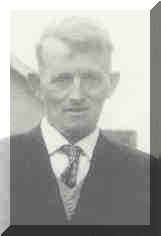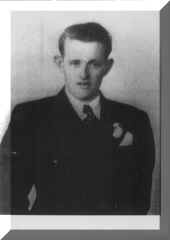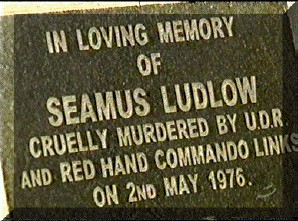The Murder of Seamus Ludlow in County Louth, May 1976. Towards a public inquiry?



The Murder of Seamus Ludlow in County Louth, May 1976. Towards a public inquiry?
|
|
Introduction to the murder of Seamus Ludlow and the official cover-up. Michael Cunningham investigation - 1978 The recent Campaign for Truth and Justice. Irish Victims Commission Report. Ludlow family's questions for the RUC (now the PSNI) Jim J. Kane's letter to the N I Human Rights Commission. Jim J. Kane's letter to the RUC Ludlow Family Letter to Bertie Ahern View messages from our original Guestbook Other Ludlow Family Sites.
|
The Dundalk Democrat, 22 May 2004: A Quiet Anniversary The anniversary of the Dublin and Monaghan bombings passed this week with very little of the publicity which surrounded the atrocities 30 years ago. There was a wreath laying ceremony at the simple and beautiful memorial on Talbot Street. An taoiseach Bertie Ahern was there with other dignitaries, but the most important in attendance were the survivors and relatives of those who lost their lives in what is still the biggest act of terrorism and loss of life in Ireland during the Troubles. The three car bombs went off within minutes of each other shortly before 5.30pm on May 17 1974. Men, women and children were killed or dreadfully mutilated in the bombings, which carried no warnings. Less than an hour later, in Monaghan town, more lives were lost when another bomb exploded. It is hard for younger people to imagine the scene of devastation and the sense of shock which reverberated around Ireland that day. Scenes of charred bodies lying on the ground, of the walking wounded stunned and bleeding, the twisted metal of what was left of the cars and the glass from dozens of shop windows strewn all around, continue to make an impact when they're shown on television. Over the last couple of weeks, the inquests have been held into the deaths of the 33 people who lost their lives that day. Witness after witness came to Dublin Coroner's Court to tell the world what they saw, what they did and how this has affected them. One survivor of the bombing was asked this week if he remembered much about that awful day. He said: "Yes, it seems like it was just yesterday". The bombings were 30 years ago but this man's life, and hundreds like him, have been put on hold because of the many unanswered questions as to the hows and whos of the Dublin and Monaghan bombings. There are those in Dundalk who too know all about unanswered questions. Maura McKeever, who lost her father, Jack Rooney, and Margaret Watters, whose father, Hugh Watters, was also murdered in the Dundalk bombing of 1975 know what it's like not to know. The Ludlow and Sharkey families are still waiting for answers about Seamus Ludlow, whose murder remains one of the Troubles most murky episodes. A full public inquiry is the only solution. It has to be asked what the government is afraid of. What are they hiding and what do they know about the shady goings-on that led to these murders and their aftermath? Huge expense is being lavished on tribunals of inquiry into dodgy planning and political backhanders. Although these are important matters, it looks like the government has got its priorities wrong. No-one died because of what Liam Lawlor or George Redmond did or didn't do. But in the very same city where those inquiries are taking place, dozens of people lost their lives 30 years ago and no-one really knows how or why. The families of those who died in Dublin, Monaghan and Dundalk have been promised much over the last three decades, but have got little. When the Dublin and Monaghan inquests are over, it's doubtful whether the families will know any more than they did this week 30 years ago. But the determination to find the truth, which has been the hallmark of these families for so many years, will not be shaken. To really draw a line under these dreadfully dark days of our history, public inquiries are needed.
The Irish Daily Star, 1 April 2004: Call for bombings inquiry in U.K. Dail committee reports findings. The Irish News, April 1 2004:'Cory-style bombings probe should be held in the north' Justice for the Forgotten at http://www.dublinmonaghanbombings.org/ The Barron Report on the May 1974 Dublin and Monaghan bombings can be downloaded in pdf format from http://www.irlgov.ie/oireachtas/Committees-29th-D%E1il/jcjedwr-debates/InterimDubMon.pdf I Homepage I I Top
I I Press Coverage I I Barron
Inquiry I I Terms of reference for Barron
Inquiry I I Fresh Inquest I I Celtic
League Support I I New
GuestMap Guest Book.
I
Copyright © 2004 the Ludlow family. All rights reserved. Revised: May 25, 2004 .
|